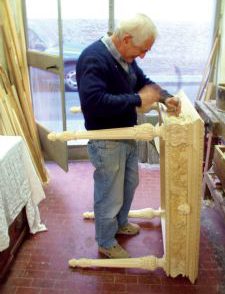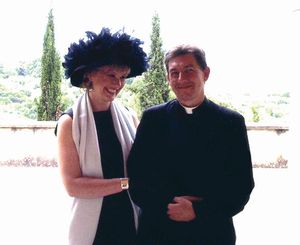More than a century ago, the glory of the Florentine artistic sights and the breath-taking views of the city and its surroundings were being caught on canvas, in sketchbooks, and in the diaries of foreign travellers during their grand tours of Italy. Their descriptions still remain, attesting to the great impact Tuscan scenery had on their eyes and imagination. As artists and aesthetes in the past unveiled Florence with illustrations and words, film directors from all over the world, who are gradually discovering the city’s photogenic quality, capture today its beauty in shots taken with the cine-camera lens.
It all began with the Florentine stories of quartiere, so vividly and dramatically described in the mid-forties by local neo-realist writer Vasco Pratolini and translated on screen in the two following decades. In 1953, Pratolini’s masterpiece Cronache di Poveri Amanti, a story of love, intrigue, and political contest set in the Florentine neighbourhood of Palazzo Vecchio in the 1920s, was his first novel to be conveyed in film, giving the city of Florence its first main appearance on the big screen. Le Ragazze di San Frediano followed in 1954, and the vitality of the noisy Oltrarno replaced the sobriety of the previous setting to match the plot’s twist of genre from drama to comedy: the love labours of a young mechanic were set in the popular district of San Frediano. Both films focused on the story and characters, leaving little room for the setting to take on great significance. An attempt to widen the focus to include the Florentine background was made in 1970 in the screen version of Metello, another novel by Pratolini. The film acknowledged the visual potential of picturesque Florence. The locations to appear in the film were scrupulously selected, and an intense effort was made to recreate the elegance of the city in the early 1900s, as had been captured by the Alinari photographs of the time.
But Florence’s first appearance as a protagonist was in 1982, when American director James Ivory adapted the early 20th century English novel A Room with a View by E.M. Forster for the screen, bringing Florence to the attention of International audiences and filmmakers. The film, faithful to the novel, traces an artistic itinerary through the main sites of the city, offering the spectator a visual Baedeker: starting from the square of S.S. Annunziata, where Eleanor Lavish and Charlotte halt under the bronze statue of Grand Duke Ferdinando I; on to the Church of Santa Croce – Lucy stops here before Dante Alighieri’s sepulchre and is introduced to Giotto’s frescoes; and through narrow, undisclosed streets, to reach Piazza della Signoria and the Loggia dei Lanzi, where the camera lingers on the vigorous bodies and fierce faces moulded by Giambologna and Cellini.
The vibrant close-ups close in on the statues’ violent and angry expressions, which introduce the brutality of the stabbing scene that follows in the square. The artistic itinerary proceeds to include a more intimate sort of trip: Lucy’s sentimental journey. While discovering streets and districts, she gradually comes to unveil and confront her own sentiments.
Both journeys begin on the River Arno, at the Pensione Bertolini – which does not really exist, as the view and the interior belong to two different pensions, Quisisana and Annalena – and conclude with the closing scene in that same room with a view where it all began.
If Ivory lingers on the visual description of the city, then New Zealander director Jane Campion intentionally avoids any immediate reference to it. In the summer of 1996, Campion was shooting a long episode of Henry James’ A Portrait of a Lady in the centre of Florence. Although the city was again the elected place in which the heroine would face her intimate passions, here it is not easy to distinguish the Florentine locations used. Far from having any aesthetic purpose, and devoted to the dark, psychological substrate for the novel – translated on screen with a recurrence of indoor scenes, the director deliberately chooses to make the various settings as unrecognisable as possible. The first glimpse of Florence is through a thick yellow mist which creates a surreal, dream-like atmosphere.
We are allowed a quick sighting of the Duomo, but only through a rapid shot filmed with a delirious, zigzag movement of the camera, contributing to the vertigo effect permeating the whole film.
One can recognize S.S. Annunziata, littered with remnants of vegetables from a market, as well as the beautiful ballroom of Palazzo Corsini, a 16th-century palace on the lungarno with a view of the river and used for the ball scene at the Osmonds’ residence. But Campion’s Florence remains an imaginary place of light and shadows, and, similarly to all the other English and Italian locations used for the film, it is de-constructed and re-created with the purpose of conveying a sense of psychological disturbance.
It is converted into a labyrinth of indefinite surroundings reflecting Isabel’s internal turmoil of doubt, anxiety, and distress, and at the end of this Florentine sojourn, one has the feeling of never having visited a real city, but the very regions of the protagonist’s psyche.
A far more enjoyable tour is offered by Sir Franco Zeffirelli in Tea with Mussolini (1999). The Florentine director escorts the spectator through a variety of sites belonging to his childhood: the camera-lens is wide-open – like the eyes of little Luca – to the artistic beauties of the city, combining with great naturalness scenes of ordinary life and historic vistas.
We cross in the opening scene – after a first view of the Arno and the Old Bridge – a crowded Piazza del Duomo, in the direction of the English Cemetery at the Piazzale Donatello; we reach S.S. Annunziata and the Ospedale degli Innocenti (where illegitimate children were abandoned); we linger on the lungarno then cross Santa Maria Novella (Zeffirelli sets Luca’s school here); we catch a glimpse of the Art Institute, of the original Doney Bar in Via de’ Tornabuoni; and we stop for a tea at the Uffizi. But this excursion around the city is not for tourists. There is no educational intent in Zeffirelli’s gallery of sites, just a desire for a private recollection of the places and sights of his memory, a need to review them – as if he were recording his own photographic album – and to recall with sweet nostalgia forgotten views, their beauty spontaneously arising from the screen.
The lavishness of Florence has not only inspired stories of romantic passions and nostalgic reminiscence, but has also hosted films of a different genre. From a novel by Somerset Maugham, Up at the Villa (1990) sets the dark plot of an adulterous passion ending in tragedy in Fascist Florence. The film does not lack shots of the city; sights of the Uffizi by night, San Miniato al Monte, the Florentine panorama from the hills, the garden of Pratolino; ever-insistent on the charming but dangerous power of Florence for inspiring the lack of all moral control, the same power which brings the protagonist to her final ruin. De Palma found in Florence the perfect location for a psychological thriller on re-incarnation in Obsession (1976).
Years later, Ridley Scott in 2001 shot the first, long part of the third chapter on the life and deeds of serial killer Hannibal Lecter here as well. Hannibal unfolds within a gothic Florence, the interiors and outdoor locations photographed to convey a feeling of danger and horror. Lecter’s home, looking out onto S.S Annunziata, is gloomy and furnished in a gothic style. The Sala dei Cinquecento in Palazzo Vecchio, where Hannibal holds his lectures, is filmed in obscurity; the Old Bridge photographed at sunset, with a red light glowing on it; and Piazza della Signoria is surrounded by menacing shadows.
At the Porcellino Fountain, behind the Mercato Nuovo, detective Rinaldo Pazzi washes away the blood from his hands, and Palazzo Vecchio hosts the final confrontation between Pazzi and Lecter, ending with Pazzi’s tragic death, which re-enacts that of his ancestor, Francesco Pazzi, who was disembowelled and hung from one of the windows.
Florence offers many different facets to the eyes of directors, and it can be easily adapted to suit their artistic tastes and needs – not least the comic, light-hearted needs of local directors, from Francesco Nuti to Leonardo Pieraccioni to Benigni. A new cinematographic era for Renaissance Florence is about to start. The city will soon be engaged in a compelling project, which has amongst its main promoters director Zeffirelli. From 2002 to 2005, a series of twelve fiction films on twelve Italian cities during the 16th century will be shot under the title The Renaissance, and Zeffirelli will direct the Florentine episode, I Fiorentini.
Henry James wrote about Florence in his Italian Hours: “What it is that infuses so rich an interest into the general charm is difficult to say in a few words.” Directors today are attempting to capture the profound meaning of Florence’s allure. But it is difficult to describe it in a few shots.






